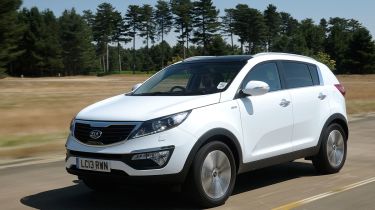Subaru Forester
Is the bigger, better new Subaru Forester now a compact SUV contender?
In the company of the best SUVs, the latest Forester looks out of place. Not only is its styling outdated, it trails the CX-5 on handling, ride and performance. Practicality and build quality are decent, but the boxer diesel engine feels flat at low revs and needs to be worked hard, while refinement isn’t up to class standards.
With its beefed-up estate car styling, the Subaru Forester is often overlooked in the congested compact 4x4 market. And while this model is all-new, visually it’s not a major departure from previous generations. In fact, from some angles it resembles a Nissan X-Trail – and compared to its rivals in this test, it looks old-fashioned.
However, the new Subaru Forester is 2mm taller than the outgoing car, at 1,735mm, as well as 15mm wider and 35mm longer, at 1,795mm by 4,595mm. So it’s the longest, tallest car of this group.
Crucially, the wheelbase is 25mm longer than before, and as a result the Subaru Forester offers similar rear legroom to the Mazda CX-5. Plus, a relatively flat transmission tunnel ensures decent comfort if you’re sitting in the middle. And despite a shorter load length, the boot is near-identical to the CX-5’s, at 505 litres.
Used - available now

2022 Mercedes
GLC
35,992 milesAutomaticDiesel2.0L
Cash £27,300
2023 Peugeot
208
19,061 milesManualPetrol1.2L
Cash £14,752
2018 Volkswagen
Scirocco
70,657 milesManualPetrol1.4L
Cash £10,350
2021 Ford
Fiesta
23,384 milesManualPetrol1.0L
Cash £12,495With this sort of practicality, it’s easy to see why Subaru expects the Forester to be its most popular model in the UK. But while anyone upgrading from the previous car will be happy with the extra space, the dated and uninspiring cabin is unlikely to draw in new customers. Build quality is solid and everything feels well bolted together, but hard plastics and an old-fashioned audio system let the Subaru Forester down.
It’s not all bad news, though. You get a leather steering wheel and gearlever, while the electric seats have plenty of adjustment. And although the view of the road isn’t as good as in either rival, overall driver comfort impresses. A big centre bin provides decent cabin stowage, while the small centre screen shows trip information and real-time fuel economy. In a nod to the Subaru’s off-road ability, another read-out displays where the 4WD transmission is distributing the torque.
The all-wheel drive system is matched to Subaru Forester’s unique 2.0-litre flat-four diesel. This engine delivers 145bhp and 350Nm of torque at just 1,600rpm, and takes the car from 0-60mph in 9.8 seconds. That’s just three-tenths down on the more powerful Mazda, plus the Forester is quicker than the Kia Sportage in the higher gears.
But while the diesel is relatively refined, there’s a flat spot in the power delivery and it has to be worked hard, so it’s not as relaxing to live with as the smooth and punchy 2.2-litre in the CX-5. On top of that, the six-speed manual gearbox has a notchy shift action and all of the Subaru’s mechanicals suffer from a slightly agricultural feel.
The Subaru Forester falls further behind when it comes to the ride and handling. With a light front, it runs out of grip sooner. It pushes its nose wide and never feels as composed or stable as the Mazda, plus there’s more road noise at speed.
As the steering is slow, you need to put in plenty of lock to get a reaction, while the weighting and feedback lack the Mazda’s natural feel. Unfortunately, the suspension delivers a bouncy and unsettled ride on rural roads, plus a crashy low-speed ride in town. Still, traction is strong, and Subaru Forester’s famed off-road ability is likely to appeal to anyone taking their compact SUV off the beaten track – unlike its rivals’ systems, the Forester’s all-wheel-drive set-up is permanently engaged.
You get loads of kit for your money with the Subaru, as the XC has heated seats, a rear view camera, power-fold mirrors and cruise control. There’s also a large sunroof, which lets in lots of light. And although sat-nav is a dealer-fit option – it’s included on the other cars here – Bluetooth connectivity is standard.
Further adding to the Forester’s financial appeal is the five-year/100,000-mile warranty, while Subaru’s network finished second in our Driver Power 2013 dealer survey.
But private buyers may be deterred by the poor residual values. The car is predicted to lose just over £3,000 more in depreciation than the Kia over three years. Servicing is also expensive, while there’s no pre-paid deal.
Company car drivers will also suffer, as the 156g/km emissions make the Forester a costly choice for business users compared to the more powerful yet cleaner Mazda.
So while the new Forester is bigger and better equipped than before, and will appeal to owners of the previous model, the sums don’t necessarily add up. And it may struggle to tempt new buyers into Subaru showrooms.







